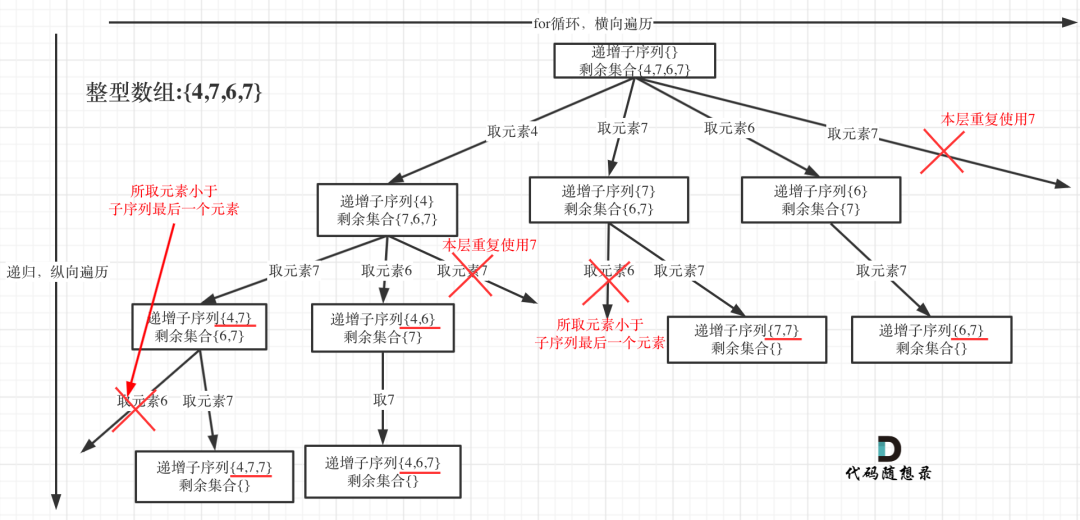LeetCode491. 递增子序列
题目
给定一个整型数组, 你的任务是找到所有该数组的递增子序列,递增子序列的长度至少是2。
- 给定数组的长度不会超过15。
- 数组中的整数范围是 [-100,100]。
- 给定数组中可能包含重复数字,相等的数字应该被视为递增的一种情况。
法一分析
自己首先想法:本题和取子集的题目差不多,但不能通过排序+used数组来去重,因为是递增子序列,不可破坏原本子序列次序。我是通过把每次结果放到 set 里面来把结果进行去重。何时将结果加入 set ? 它和取子集问题一样,不必到叶子结点,每层都取,也就是进入下层后要将上层结果存入 set 中。最后再把set 中的结果放入 res中。
法一代码
1 class Solution { 2 public: 3 vector<int>path; 4 vector<vector<int>>res; 5 set<vector<int>>s; 6 bool check(vector<int>nums){ 7 for(int i = 1;i < nums.size();i++){ 8 if(nums[i] < nums[i-1]) return false; 9 } 10 return true; 11 } 12 void backtracking(vector<int> nums,int startIndex){ 13 if(check(path) && path.size() >= 2){ 14 s.emplace(path); 15 //res.push_back(path); 16 } 17 18 if(!check(path)) return; 19 20 for(int i = startIndex;i < nums.size();i++){ 21 path.push_back(nums[i]); 22 backtracking(nums,i+1); 23 path.pop_back(); 24 } 25 } 26 27 vector<vector<int>> findSubsequences(vector<int>& nums) { 28 backtracking(nums,0); 29 for(auto it:s){ 30 res.push_back(it); 31 } 32 return res; 33 } 34 };
上面set可使用unordered_set
法二分析 按照Carl的思路

直接排除可能重复的情形:只要同层重复使用元素,递增子序列就会重复 。注意要与 求子集问题(二)中去重区别。子集问题二是先排序然后看相邻元素是否重复使用。
判断递增:如果选取的元素小于子序列里面最后一个元素,那么pass,着说明了不是递增。去重逻辑代码如下:
if ((!path.empty() && nums[i] < path.back())
|| uset.find(nums[i]) != uset.end()) {
continue;
}
注意 本题的数据范围为 [-100,100],数据范围小,可以直接用数组进行哈希,这样比set快。
法二代码
1 class Solution { 2 public: 3 vector<int>path; 4 vector<vector<int>>res; 5 6 void backtracking(vector<int> nums,int startIndex){ 7 if(path.size() > 1) { 8 res.push_back(path); 9 } 10 int used[201] = {0}; // 用数组来去重,数据范围是-100,100 11 12 for(int i = startIndex;i < nums.size();i++){ 13 //非递增或者重复直接pass 14 if((!path.empty() && path.back() > nums[i]) 15 || used[100+nums[i]] == 1) continue; 16 17 used[100+nums[i]] = 1; //表示这个元素使用过了 18 path.push_back(nums[i]); 19 backtracking(nums,i+1); 20 path.pop_back(); 21 //注意不在这里恢复used数值,在下一层恢复used数值 22 } 23 } 24 25 vector<vector<int>> findSubsequences(vector<int>& nums) { 26 backtracking(nums,0); 27 return res; 28 } 29 };
注意上面代码,used数组恢复位置,本层不恢复。


